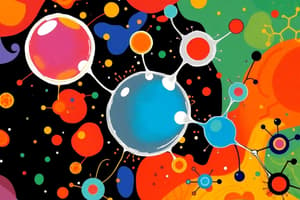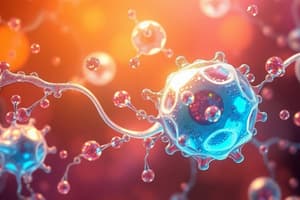Podcast
Questions and Answers
What is the primary reason for the abundance of oxygen and hydrogen in living organisms?
What is the primary reason for the abundance of oxygen and hydrogen in living organisms?
- They are the most reactive elements.
- Water, which contains these elements, is ubiquitous. (correct)
- They form strong ionic bonds with carbon.
- They are essential for photosynthesis.
Which of the following elements constitutes 98% of a living organism's composition?
Which of the following elements constitutes 98% of a living organism's composition?
- Oxygen, Hydrogen, Carbon (correct)
- Oxygen, Nitrogen, Manganese
- Carbon, Nitrogen, Phosphorus
- Nitrogen, Sulfur, Iron
What are the four major classes of biological molecules found in all life forms?
What are the four major classes of biological molecules found in all life forms?
- Lipids, Nucleic acids, Amino acids, Sugars
- Proteins, Nucleic acids, Carbohydrates, Lipids (correct)
- Nucleic acids, Sugars, Vitamins, Lipids
- Proteins, Carbohydrates, Enzymes, Nucleic acids
What does the Central Dogma explain in living systems?
What does the Central Dogma explain in living systems?
Which statement best distinguishes prokaryotic cells from eukaryotic cells?
Which statement best distinguishes prokaryotic cells from eukaryotic cells?
What is a common characteristic of carbon in biological molecules?
What is a common characteristic of carbon in biological molecules?
Which element is NOT considered one of the major components of living organisms?
Which element is NOT considered one of the major components of living organisms?
How many different substances does the human body contain?
How many different substances does the human body contain?
What is the primary role of DNA polymerase in the process of DNA replication?
What is the primary role of DNA polymerase in the process of DNA replication?
What is the function of RNA polymerase during transcription?
What is the function of RNA polymerase during transcription?
Which organelle is primarily responsible for ATP production in a cell?
Which organelle is primarily responsible for ATP production in a cell?
What role do ribosomes play in the process of translation?
What role do ribosomes play in the process of translation?
What is the primary function of the Golgi complex?
What is the primary function of the Golgi complex?
Which cell structure is characterized as the information center of the cell?
Which cell structure is characterized as the information center of the cell?
What process does the rough endoplasmic reticulum (ER) primarily specialize in?
What process does the rough endoplasmic reticulum (ER) primarily specialize in?
What is the primary function of lysosomes within a cell?
What is the primary function of lysosomes within a cell?
What is the primary role of proteins in living cells?
What is the primary role of proteins in living cells?
Which statement is true about nucleic acids?
Which statement is true about nucleic acids?
What distinguishes DNA from RNA?
What distinguishes DNA from RNA?
How do lipids primarily function in cells?
How do lipids primarily function in cells?
What role do carbohydrates play in living organisms?
What role do carbohydrates play in living organisms?
What is referred to as the 'command and control centre' of the cell?
What is referred to as the 'command and control centre' of the cell?
Which of the following statements about glycogen is correct?
Which of the following statements about glycogen is correct?
What does the central dogma of molecular biology describe?
What does the central dogma of molecular biology describe?
Flashcards are hidden until you start studying
Study Notes
Unity of Life
- All organisms share remarkable uniformity at the molecular level, exemplified by Jaques Monod's quote linking E. coli and elephants.
- Organisms consist primarily of a limited number of elements, significantly dominated by hydrogen, oxygen, carbon, and nitrogen.
Composition of Living Organisms
- Approximately 98% of a living organism is made up of hydrogen, oxygen, and carbon.
- Carbon's strength in forming stable bonds makes it central to large biological molecules.
- Other elements like phosphorus, sulfur, iron, and magnesium are also essential, but make up a smaller percentage.
Major Classes of Biological Molecules
- Four primary types of biomolecules are essential for all life forms:
- Proteins: Essential for cell structure, mobility, immune function, signaling, and catalyzing reactions.
- Nucleic Acids: Serve as the command center for cells, consisting of DNA and RNA, crucial for storing and transferring genetic information.
- Lipids: Function as cellular energy sources and form membranes; not polymers like the other classes.
- Carbohydrates: Act as energy sources (e.g., glucose and glycogen) and play roles in cellular recognition.
The Central Dogma of Molecular Biology
- Proposed by Francis Crick in 1958, describing the flow of genetic information.
- Key processes:
- DNA Replication: Enzyme DNA polymerase synthesizes new DNA strands.
- Transcription: RNA polymerase transcribes DNA to mRNA.
- Translation: mRNA is translated into proteins at ribosomes.
Eukaryotic vs. Prokaryotic Cells
- Cells are the basic unit of life, which can be unicellular or multicellular, bounded by a lipid bilayer membrane.
- Eukaryotic cells contain a nucleus (the largest organelle) and other organelles like mitochondria (ATP production) and chloroplasts (photosynthesis).
- Organelles work collaboratively to process proteins and materials, highlighting the complexity of eukaryotic cells compared to prokaryotic cells.
Organelles and Their Functions
- Smooth ER: Processes external chemicals.
- Rough ER: Site of protein synthesis with ribosomes, transferring proteins to the Golgi complex.
- Golgi Complex: Modifies proteins made in the Rough ER and prepares them for transport.
- Secretory Granules: Transport proteins to the plasma membrane for secretion.
- Lysosomes: Digest damaged organelles and other materials through hydrolysis.
Studying That Suits You
Use AI to generate personalized quizzes and flashcards to suit your learning preferences.



